United Kingdom
The United Kingdom’s contribution to data for development
The United Kingdom invests in improving institutional and technical capacity and aims to stimulate and satisfy national demand for data by supporting comprehensive national strategies for the development of statistics. Its support ranges from technical assistance and financial support to national statistical offices to funding for equipment and improving donor co-ordination.
Through DFID, the United Kingdom supports an innovative project of the UN Statistics Division to develop an on line international data and visualisation platform for the Sustainable Development Goals indicators. The project will help developing countries to build their capacity in collecting, analysing and disseminating disaggregated data; modernise national statistical systems with up-to-date technology and skills; engage with key users of data; and enable multiple actors to use statistics for evidence-based decisions.
The United Kingdom is looking into the potential of big data for development co-operation and its Office for National Statistics is a member of the Global Working Group on Big Data for Official Statistics. DFID is exploring ways in which big data can improve understanding, delivery and monitoring of development challenges.
According to the 2017 Partner Report on Support to Statistics (PRESS) dataset, the United Kingdom committed on average USD 30.29 million per year to finance national statistical capacities and systems in developing countries in 2013-15.
Financial flows from the United Kingdom to developing countries
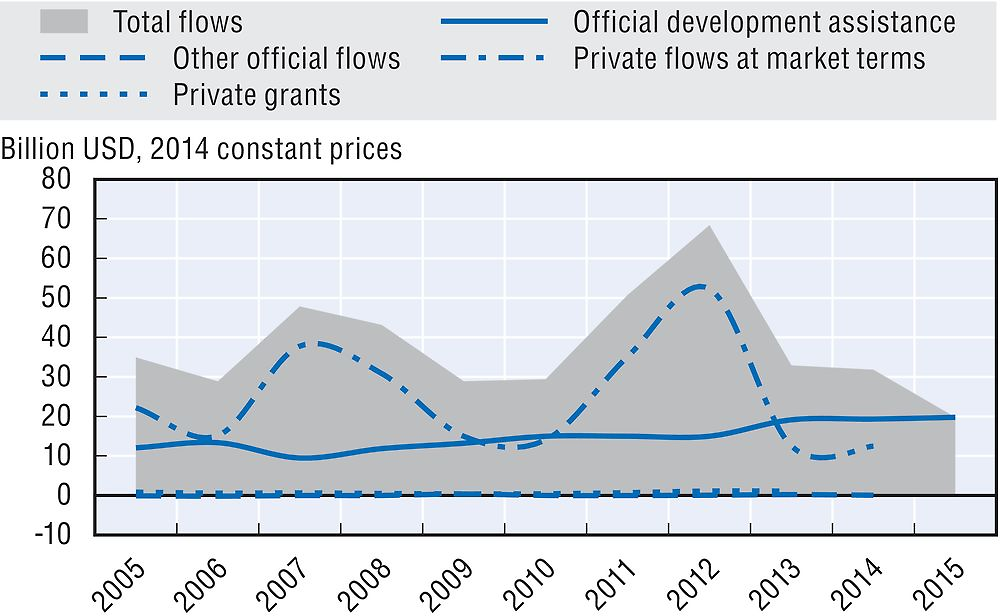
Note: Data on other official flows and on private flows at market terms are not available for 2015. Data on private grants are not available for 2014 or 2015.
The United Kingdom’s use of ODA to mobilise other resources for sustainable development
-
USD 61 million of official development assistance (ODA) was committed to the mobilisation of domestic resources in developing countries, e.g. to support the development of their tax systems, in 2015.
-
USD 1.7 billion of ODA (+71.2% in real terms from 2014) was committed to promote aid for trade and improve developing countries’ trade performance and integration into the world economy in 2015.
The United Kingdom’s performance against commitments for effective development co-operation
The United Kingdom’s official development assistance
In 2016, the United Kingdom provided USD 18 billion in net ODA (preliminary data), which represented 0.7% of gross national income (GNI) and an 8.4% increase in real terms from 2015, mainly due to the scaling up of its aid. The United Kingdom is one of only six DAC members to have met the UN target of 0.7% of ODA/GNI in 2016. It is committed to keeping this ratio stable. All of the United Kingdom’s ODA (excluding administrative costs and in-donor refugee costs) was untied in 2015, while the DAC average was 78.1%. The grant element of total ODA was 100% in 2015.
In 2016, in-donor refugee costs were USD 549 million, an increase of 59.2% in real terms over 2015, and represented 3.0% of the United Kingdom’s total net ODA.
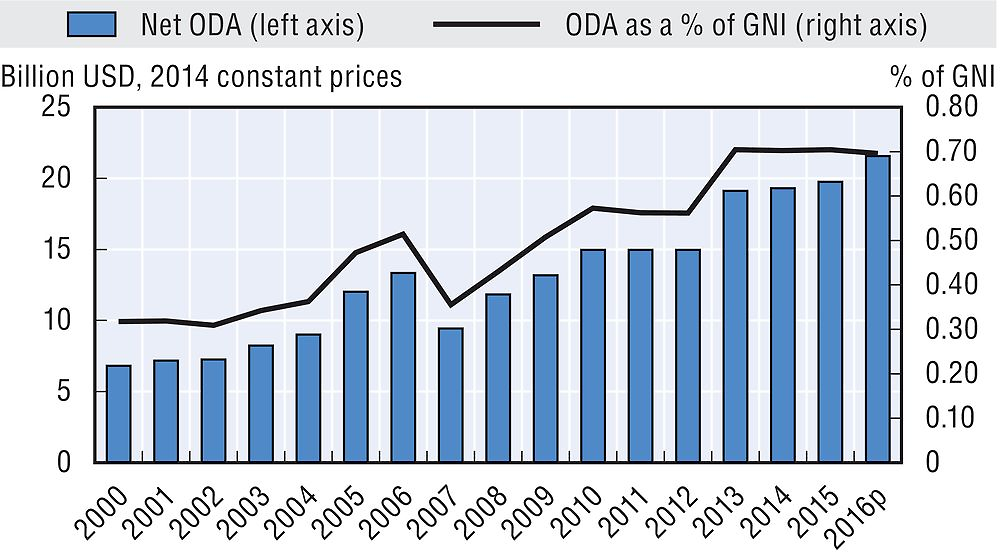
p: Preliminary data.
In 2015, 63.4% of ODA was provided bilaterally. The United Kingdom allocated 36.6% of total ODA as core contributions to multilateral organisations, compared with the DAC country average of 26.2%. In addition, it channelled 28.1% of its bilateral ODA for specific projects implemented by multilateral organisations (multi-bi/non-core contributions).
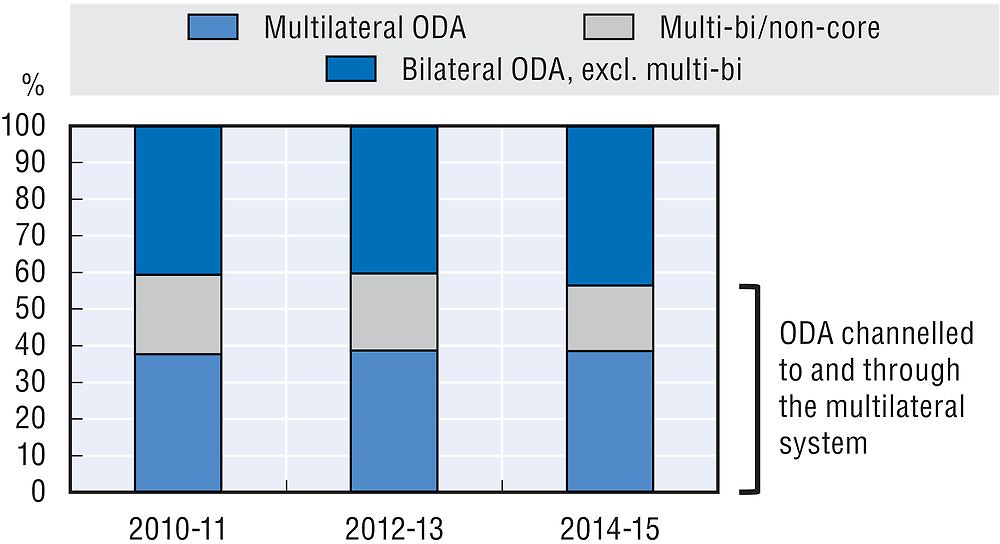
In 2015, 47.5% of bilateral ODA was programmed with partner countries. The United Kingdom’s share of country programmable aid was lower than the DAC country average (48.8%) and project-type interventions accounted for 64.8% of this aid. Twenty-one per cent of bilateral ODA was categorised as “other and unallocated” aid, and 16.7% as “humanitarian and food aid”.
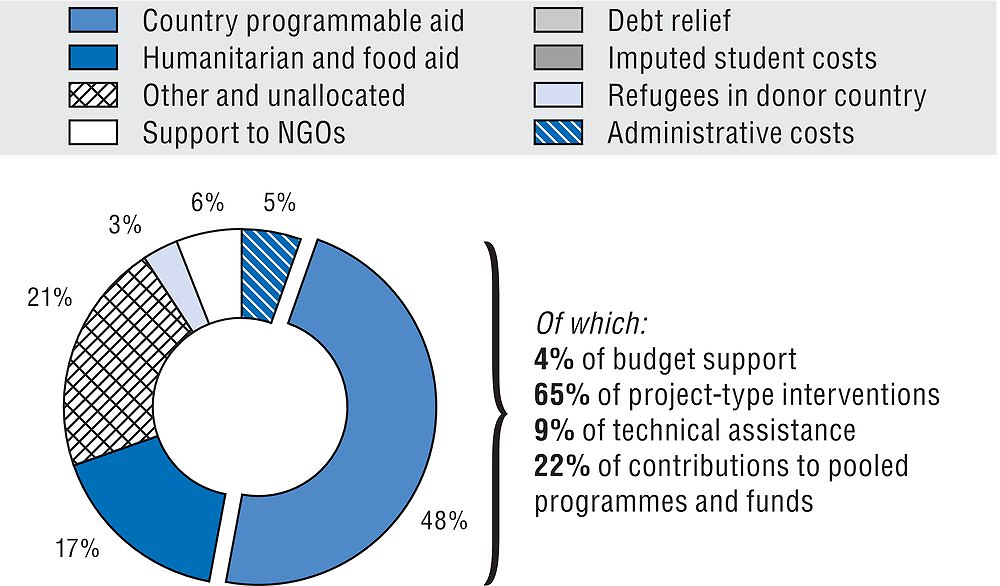
In 2015, USD 2.5 billion of bilateral ODA was channelled to and through civil society organisations (CSOs). ODA channelled to and through CSOs has increased in recent years in volume (+4% between 2014 and 2015), and remained stable as a share of bilateral ODA (21.5% in 2015). The DAC country average was 16.9% in 2015.
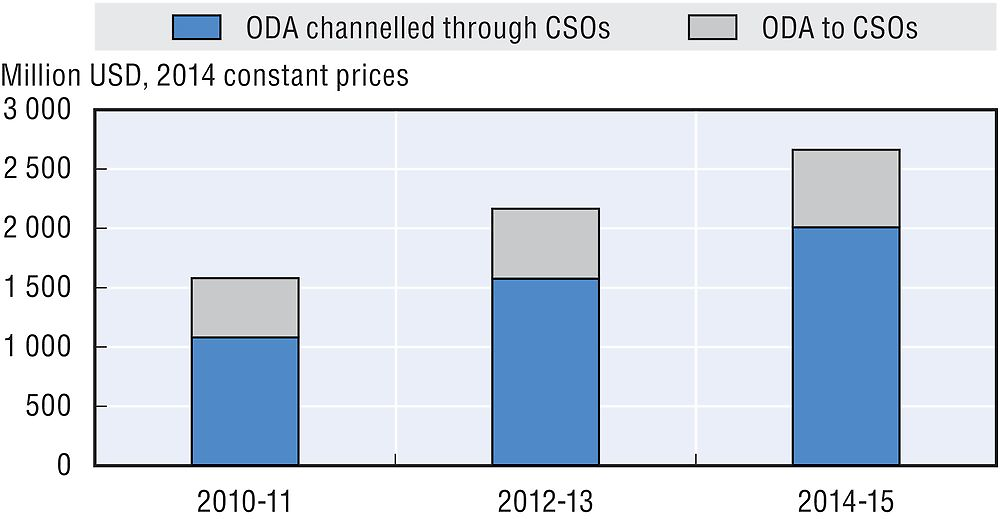
Bilateral ODA was primarily focused on sub-Saharan Africa. In 2015, USD 3.9 billion was allocated to sub-Saharan Africa and USD 2 billion to south and central Asia.
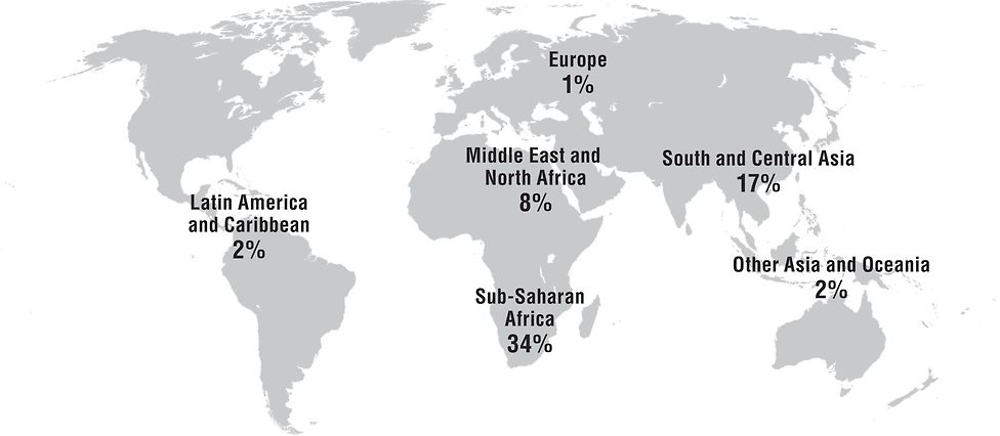
Note: 36% of bilateral ODA allocated was unspecified by region in 2014-15. This share is not represented on the map.
In 2015, 32.6% of bilateral ODA went to the United Kingdom’s top 10 recipients. The United Kingdom works in countries across Africa, Asia and the Middle East, where it also has regional programmes, including in the Caribbean. All of its top 10 recipients in 2014-15 are among its priority partner countries. DFID has increased its focus on the poorest and most fragile states: in 2015, its support to fragile contexts reached USD 5.7 billion (48.1% of gross bilateral ODA).
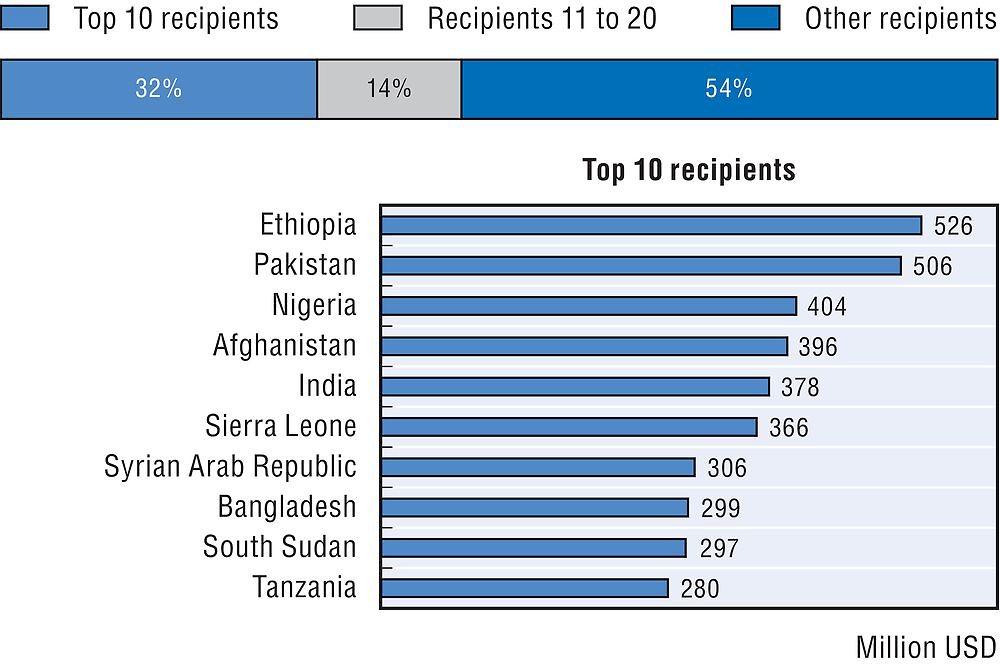
In 2015, 32.5% of bilateral ODA was allocated to least developed countries (LDCs), amounting to USD 3.9 billion. This share has remained relatively stable in recent years, and is higher than the 2015 DAC average of 24.3%. LDCs received the highest share of bilateral ODA in 2015 compared with other income groups.
At 0.23% of GNI in 2015, total ODA to LDCs was above the UN target of 0.15% of GNI.
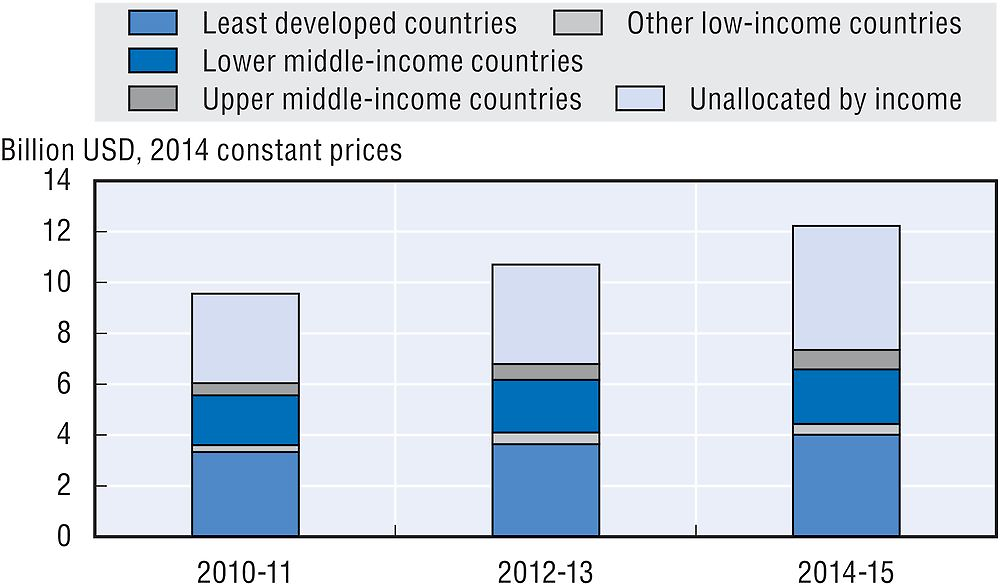
In 2015, 33.4% of bilateral ODA was allocated to social infrastructure and services, at a total of USD 3 billion, with a strong focus on government and civil society (USD 998.7 million), health (USD 632.8 million), and education (USD 600.3 million). USD 1.1 billion was allocated to economic infrastructure and services, particularly to banking and financial services (USD 719.4 million). Humanitarian aid amounted to USD 1.5 billion.

USD 2.1 billion of bilateral ODA supported gender equality in 2015. The United Kingdom’s focus on women and girls was reinforced by the 2014 Development Act on Gender Equality. Gender equality is embedded in the bilateral programme, and issues affecting women and girls are also raised on the global stage. In 2015, 40.5% of the United Kingdom’s bilateral allocable aid had gender equality and women’s empowerment as a principal or significant objective, compared with the DAC country average of 36.3%. This represents a decrease from 60.7% in 2014. The United Kingdom’s aid to water and sanitation, population and reproductive health, other social infrastructure, and education focuses on gender.
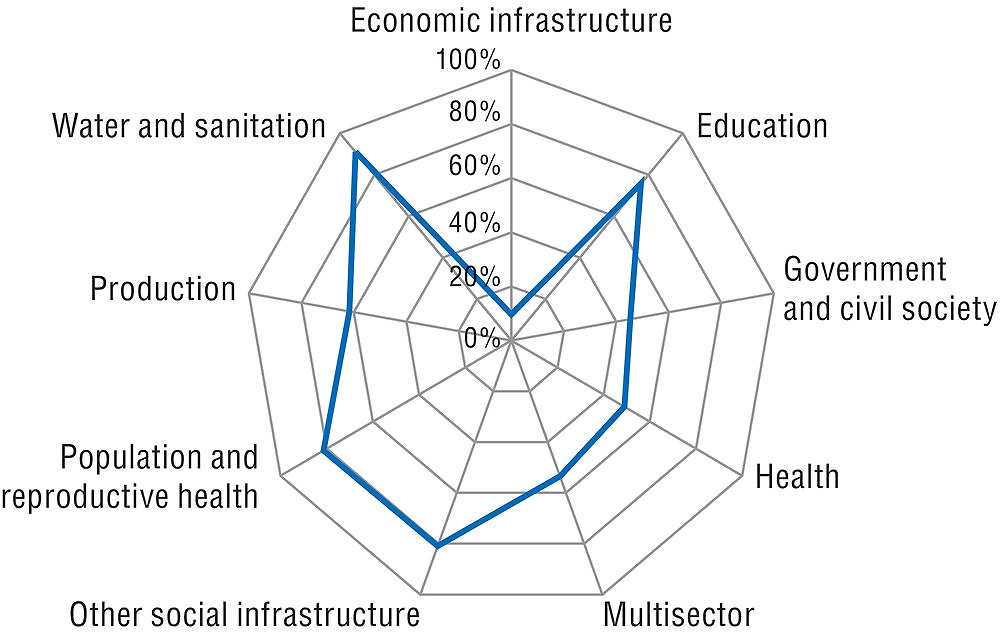
USD 2.5 billion of bilateral ODA supported the environment in 2015. The United Kingdom has set combating climate change as one of the six strategic priorities of its business plan. DFID has a comprehensive policy framework to support its engagement in the areas of environment and climate change. In particular, it has introduced a new climate and environment assessment requirement that looks at the impact of all programmes on the vulnerability of poor communities to environmental disasters and it has created an initiative called Future Fit, designed to integrate climate issues into DFID’s core business (OECD, 2014). In 2015, 33.1% of its bilateral allocable aid supported the environment and 30.6% (USD 2.3 billion) focused on climate change, compared with the respective DAC country averages of 33.2% and 26.2%.
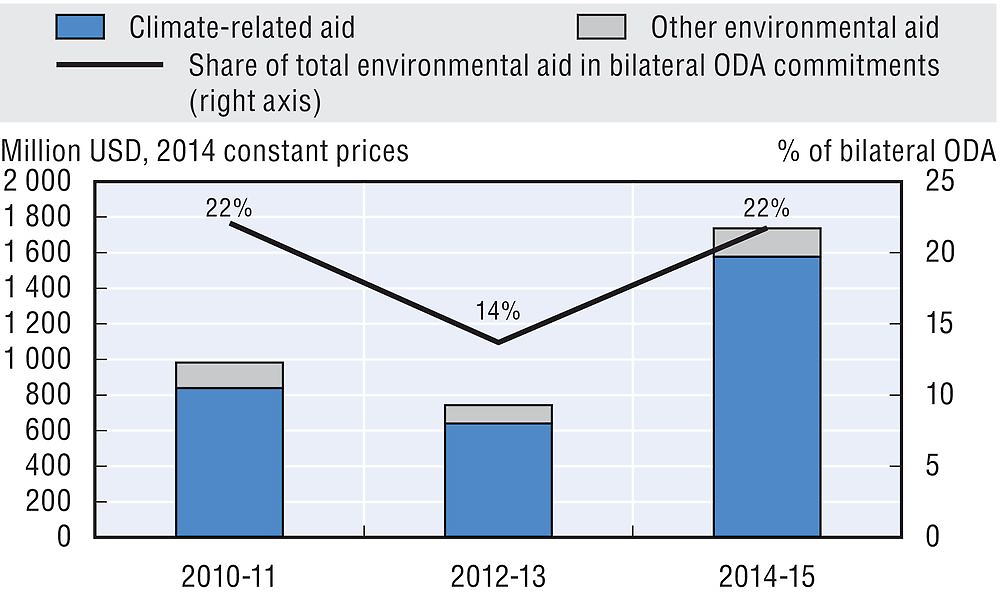
Note to reader: Annex B provides “Methodological notes on the profiles of Development Assistance Committee members”.
Reference
OECD (2014), OECD Development Co-operation Peer Reviews: United Kingdom 2014, OECD Publishing, Paris, https://doi.org/10.1787/9789264226579-en.
